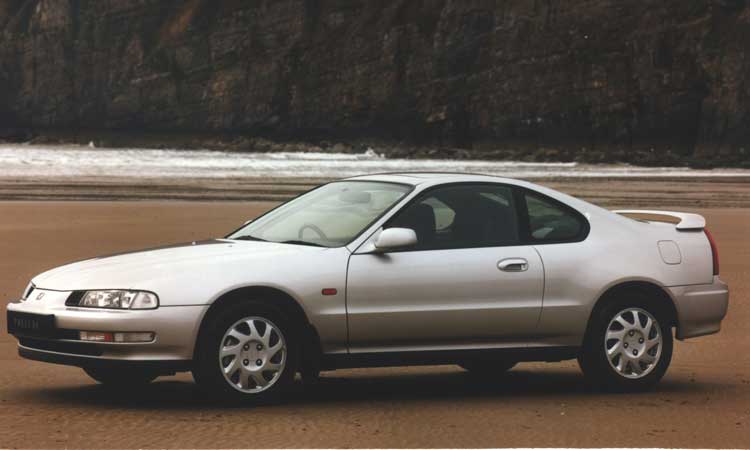Honda Prelude
We've all heard of four-wheel drive, but in the late Eighties, John Lambert found himself entranced by four-wheel steering

Back in the late 1980s, Honda was a company brimming with confidence. In 1988, Honda-powered McLarens won 15 of the season's 16 Grand Prix races; Honda's co-operation promised to revitalise Rover's fortunes as a car manufacturer; and enthusiasts were taking notice of Honda's V-tec engine in the Civic and CRX. But the best thing that Honda did back then remains under-appreciated: in 1987, Honda launched an all-new Prelude with - on the top model - four-wheel steering (4WS).
In the early 1980s, manufacturers were experimenting with different ways to improve handling and grip. One result was a number of ordinary cars with four-wheel drive; another was the option of 4WS, offered on some Honda, Mazda, Mitsubishi and Nissan cars.
Turn the steering wheel in a 4WS Honda, and the front and rear wheels move in the same direction. The rear wheels don't turn as far as the front wheels (when the latter have turned nine degrees, the former are turned two degrees) but the effect is to make the car crab slightly. Turn the steering further, and the rear wheels return to the straight-ahead position. Keep turning the steering wheel, and the rear wheels turn in the opposite direction to the front wheels (when the front wheels are on full lock, the rear wheels are turned six degrees in the opposite direction).
The theory was that small steering movements would be made at high speed; pointing the front and rear wheels in the same direction improved stability. At low speeds, more steering would be applied; turning the front and rear wheels in the opposite direction tightened the turning circle.
It all sounded very convincing; my first test-drive was enough to enchant me. Even discounting the trick steering, the Prelude was an impressive car. The performance was astonishing, the cabin comfortable, the controls a delight to the touch, and the ergonomics faultless. A few weeks later, I was driving home in my own 4WS Prelude. I chose manual over automatic. It was great to have 150bhp to play with, but I was unaccustomed to the way automatics kick down, and found it unnerving. The manual Prelude felt much calmer and more controllable.
Everything happens for the best, however, and it was good to have the experience of the five-speed transmission. Both the ratios and the action of the gear lever were wonderful; one of the best manual gearboxes I've used. The only time when the transmission was a hindrance was in traffic jams - where any manual transmission is a pain.
What impressed me was how well everything worked with everything else. The suspension helped get the power to the road without interfering with the steering. The brakes could be used to modify the attitude of the car through a corner. The transmission was a perfect match for the engine. But the best thing was the steering: whatever the road, whatever the weather, whatever the speed, the response, weighting and feedback delighted me.
The most valuable thing I learnt from my first Prelude was the true source of comfort. Previously, I thought that it was a matter of quietness, smoothness of ride and softness of upholstery. But none of those matter as much as dependable, consistent steering, brakes and power. Knowing that your car can deal with any hazard the road presents is the greatest comfort of all.
My first Prelude was a joy but, sadly, it was not to last forever. I took it to 178,000 miles and it was time to change. Thankfully, an online auction site had a 1989 Prelude 4WS automatic in desirable SE specification (leather, air-con, alloy wheels and boot spoiler) and slightly dubious gold paint. After five years with my first Prelude, I felt that automatic transmission would no longer hinder my enjoyment. There was some frantic bidding but I secured the Prelude for a modest sum.
Honda's automatic transmission, as fitted to the Prelude, had a few quirks. Learning how to use the "sport" modes and second-gear hold, lending an uncommon positivity to acceleration around tight corners, was all part of the fun. Getting used to the position of the pedal for left-foot braking was uncomfortable but worthwhile. The leather seats were even comfier than the cloth-trimmed ones in my old Prelude.
The best thing about my second Prelude was that I obtained a second-hand set of alloy wheels and low-profile tyres (see picture). I was warned that the ride would be ruined, wet grip impaired, breakaway more sudden. None of this happened: the steering response was even sweeter.
With decent tyres, automatic transmission and leather seats, this Prelude was even more captivating than my first. On several occasions, I would return from a banal journey with my heart singing, marvelling at how pleasant the Prelude made it. If something inside the engine hadn't let go, I'd be marvelling still.
Join our commenting forum
Join thought-provoking conversations, follow other Independent readers and see their replies
Comments
Bookmark popover
Removed from bookmarks